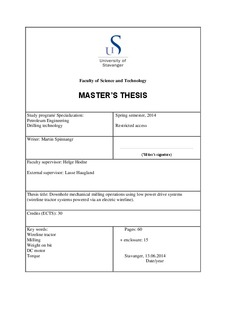| dc.contributor.author | Spinnangr, Martin | |
| dc.date.accessioned | 2014-06-15T18:42:48Z | |
| dc.date.available | 2014-06-15T18:42:48Z | |
| dc.date.issued | 2014-06-13 | |
| dc.identifier.uri | http://hdl.handle.net/11250/196459 | |
| dc.description | Master's thesis in Petroleum engineering | nb_NO |
| dc.description.abstract | Wireline tractor milling is getting more common and it is expected continue to growing in the next decades. The technology will potentially take over more of the downhole milling marked, and its full potential will come to show with new technological improvements and better utilization of the technology already in place. For now coiled tubing technology is a preferred intervention method for many milling operations, as it is stronger than tractor milling and has the ability to circulate debris and swarf. The downside with a coiled tubing unit is that it needs longer rig-up time, larger field staff and will have a much greater cost then wireline tractor technology. For these reasons a proven tractor milling technology will most likely be preferred over coiled tubing units in the future.
The goal with this thesis was to utilize the limited power available from the tractor toolstring and verify how to best make a hole of four inches in high alloy steel obstacles. Several tests and theoretical calculations were carried out to verify the best suited bit and to find the best possible operational window, i.e. rotational speed and weight on bit, for these bits.
From the conducted tests it was concluded that the tractor technology is strong enough to mill through high alloy steel obstacles, but that the technology is still not ready to take on the most difficult milling tasks. Surprisingly enough, it was a standard hole saw that had the best test results and was capable of cutting through steel plates of 13Cr, S13Cr and Inconel 718. The diamond grinding bits turned out to work on both 13Cr and S13Cr, but not so well on Inconel 718 obstacles. It was also concluded that for some operations the present toolstring design is insufficient, or at least not optimal. A proper milling toolstring design should include good centralisation close to the bit and a reliable method to control the weight on bit. Therefore, a new weight on bit control concept is presented. The new concept is mainly meant as a quick fix solution, while more comprehensive and advanced weight control units are being developed. | nb_NO |
| dc.language.iso | eng | nb_NO |
| dc.publisher | University of Stavanger, Norway | nb_NO |
| dc.relation.ispartofseries | Masteroppgave/UIS-TN-IPT/2014; | |
| dc.rights | Attribution-NonCommercial-NoDerivs 3.0 Norway | * |
| dc.rights.uri | http://creativecommons.org/licenses/by-nc-nd/3.0/no/ | * |
| dc.subject | petroleumsteknologi | nb_NO |
| dc.subject | boreteknologi | nb_NO |
| dc.title | Downhole mechanical milling operations using low power drive systems (wireline tractor systems powered via an electric wireline) | nb_NO |
| dc.type | Master thesis | nb_NO |

